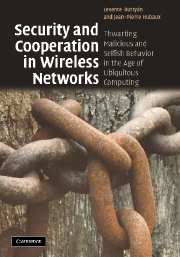 Security and Cooperation in Wireless Networks
Security and Cooperation in Wireless Networks Appendix A - Introduction to cryptographic algorithms and protocols
Published online by Cambridge University Press: 05 June 2012
Summary
Introduction
Security of information and communication systems is concerned with the prevention or the detection (if prevention is not possible or too costly) of attacks, where an attack is meant to be a deliberate attempt to compromise the system. A system is compromised if it reaches a non-desirable state or it behaves in a non-desirable way, and where the latter can be the result of the former.
A system can also reach a non-desirable state or behave in a non-desirable manner due to some random faults. Random faults, however, are usually less sophisticated than attacks; hence, coping with attacks is more difficult. For instance, a Cyclic Redundancy Code (CRC) can detect random errors in a transmitted message well enough, but it is ineffective in detecting deliberate modifications, because an attacker can compute the correct CRC value for the modified message.
Stealing a password file and cracking passwords off-line is an example of an attack. In this case, the attacker tries to put the system into a non-desirable state where some passwords are known not only to the corresponding legitimate users, but also to the attacker. This allows the attacker to login in the name of a legitimate user and to use the privileges of that user to perform some operations in the system. This then allows the attacker to further compromise the system. For instance, the attacker can modify or delete some important configuration files, which can lead to a non-desirable behavior of the system.
- Type
- Chapter
- Information
- Security and Cooperation in Wireless NetworksThwarting Malicious and Selfish Behavior in the Age of Ubiquitous Computing, pp. 393 - 422Publisher: Cambridge University PressPrint publication year: 2007


